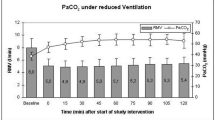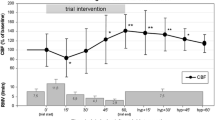Summary
The purpose of this study was to compare the effect of hyper-ventilation and indomethacin on cerebral circulation, metabolism and pressures in patients with acute severe head injury in order to see if indomethacin may act supplementary to hyperventilation. Fourteen severely head injured patients entered the study. Intracranial pressure (ICP), mean arterial blood pressure (MABP) and cerebral perfusion pressure (CPP) were monitored continuously. Within the first four days after the trauma the CO2 and indomethacin vasoreactivities were studied by measurements of cerebral blood flow (CBF) (Cerebrograph 10a, intravenous133Xe technique) and arterio-venous difference of oxygen (AVdO2). Ischaemia was evaluated from changes in CBF, saturation of oxygen in the jugular bulb (SvjO2), lactate and lactate/oxygen index (LOI). Data are presented as medians and ranges, results are significant unless otherwise indicated.
Before intervention ICP was well controlled (14.8 (9–24) mmHg) and basic CBF level was 39.1 (21.6–75.0) ml/100 g/min). The arterio-venous oxygen differences were generally decreased (AVdO2 = 4.3 (1.8–8.1) ml/100 ml) indicating moderate luxury perfusion. Levels of CMRO2 were decreased (1.54 (0.7–3.2) ml/100 g/min) as well.
Duringhyperventilation (ΔAPaCO2 = 0.88 (0.62–1.55) kPa) CBF decreased with 11.8 (−33.4−29.7) %/kPa and ICP decreased with 3.8 (0–10) mmHg. AVdO2 increased 34.0 (4.0–139.2) %/kPa, MABP was unchanged, CMRO2 and CPP increased (ΔCPP = 3.9 (−10−20) mmHg). AVD (lactate) and LOI were unchanged. No correlations between CBF responses to hypocapnia and outcomes were observed.
An i.v. bolus dose ofindomethacin (30 mg) decreased CBF 14.7 (−16.7−57.4) % and ICP decreased 4.3 (−1−17) mmHg. AVdO2 increased 27.8 (−40.0−66.7)%, MABP (ΔMABP = 4.9 (−2−21) mmHg) and CPP (ΔCPP = 8.7 (3–29) mmHg) increased while CMRO2 was unchanged. No changes in AVd (lactate) and LOI indicating cerebral ischaemia were found.
Compared to hyperventilation (changes per 1 kPa, at PaCO2 level = 4.05 kPa) the changes in MABP, CPP and CBF were significantly greater after indomethacin, while the changes in AVdO2, ICP, SvjO2, and LOI were of the same order of magnitude.
Nocorrelation between relative reactivities to indomethacin and CO2, evaluated from changes in CBF and AVdO2, or between the decrease in ICP after the two procedures were found. Thus, some patients reacted to indomethacin but not to hyperventilation, and vice versa.
These results suggest that indomethacin and hyperventilation might act independently, or in a complementary fashion in the treatment of patients with severe head injury.
Similar content being viewed by others
References
Armstead WM, Mirro R, Busija DW, Leffler CW (1991) Opioids and the prostanoid system in the control of cerebral blood flow in hypotensive piglets. J Cereb Blood Flow Metab 11: 380–387
Armstead WM, Mirro R, Busija DW, Leffler CW (1990) Prostanoids modulate opioid cerebrovascular responses in newborn pigs. J Pharm Exp Ther 255: 1083–1089
Dahlgren N, Nilsson B, Sakabe T, Siesjö BK (1981) The effect of indomethacin on cerebral blood flow and oxygen consumption in the rat at normal and increased carbon dioxide tensions. Acta Physiol Scand 111: 475–485
DeGiuilo PA, Roth RA, Mishra OP, Delivoria-Papadopolos W, Wagerle LC (1989) Effect of indomethacin on the regulation of cerebral blood flow during respiratory alkalosis in newborn piglets. Pediatr Res 26: 593–597
Edwards AD, Wyatt JS, Richardson C, Potter A, Cope M, Delpy DT, Reynolds EOR (1990) Effects of indomethacin on cerebral haemodynamics in very preterm infants. Lancet 335: 1491–1495
Edvinsson L, MacKenzie ET, McCulloch J (1993) Cerebral blood flow and metabolism. Raven, New York, pp 354–362
Ellis EF, Police RJ, Yancey L, McKinney JS, Amruthesh SC (1990) Dilatation of cerebral arterioles by cytocrome P-450 metabolites of arachidonic acid. Am J Physiol 259 (Heart Circ Physiol 28): H1171-H1177
Jensen K, Öhrström J, Cold GE, Astrup J (1991) The effects of indomethacin on intracranial pressure, cerebral blood flow and cerebral metabolism in patients with severe head injury and intracranial hypertension. Acta Neurochir (Wien) 108: 116–121
Messeter K, Nordström C-H, Sundbärg G, Algotsson L, Ryding E (1986) Cerebral hemodynamics in patients with acute severe head trauma. J Neurosurg 64: 231–237
Miller JD, Becker DP, Ward JD, Sullivan HG, Adams WE, Rosner MJ (1977) Significance of intracranial hypertension in severe head injury. J Neurosurg 47: 503–516
Miller JD (1981) Barbiturates and raised intracranial pressure. Ann Neurol 6: 189–193
Moskopp D, Ries F, Wassmann H, Nadstawek J (1991) Barbiturates in severe head injuries? Neurosurg Rev 14: 195–202
Muizelaar JP, Marmarou A, Ward JD, Kontos HA, Choi SC, Becker DP, Gruemer H, Young HF (1991) Adverse effects of prolonged hyperventilation in patients with severe head injury: a randomized clinical trial. J Neurosurg 75: 731–739
Pickard JD, MacKenzie ET (1973) Inhibition of prostaglandin synthesis and the response of baboon cerebral circulation to carbon dioxide. Nature New Biol 245: 187–188
Robertson CS, Narayan RK, Gokaslan ZL, Pahwa R, Grossman RG, Caram P, Allen E (1989) Cerebral arteriovenous oxygen difference as an estimate of cerebral blood flow in comatose patients. J Neurosurg 70: 222–230
Sakabe T, Siesjö BK (1979) The effect of indomethacin on blood flow metabolism couple in the brain under normal, hypercapnic and hypoxic conditions. Acta Physiol Scand 107: 283–284
Schalèn W, Messeter K, Nordström CH (1991) Cerebral vasoreactivity and the prediction of outcome in severe traumatic brain lesions. Acta Anaesthesiol Scand 35: 113–122
Wang Q, Paulson OB, Lassen NA (1993) Indomethacin abolishes cerebral blood flow increase in response to acetazolamide-induced extracellular acidosis: a mechanism for its effect on hypercapnia. J Cereb Blood Flow Metab 13: 724–727
Ward JD, Becker DP, Choi SC, Marmarou A, Wood C, Newlon PG, Keenan R (1985) Failure of prophylactic barbiturate coma in the treatment of severe head injury. J Neurosurg 62: 383–388
Wennmalm Å, Carlsson I, Edlund A, Eriksson S, Kaijser L, Nowak S (1984) Central and peripheral haemodynamic effects of non-steroidal antiinflammatory drugs in man. Arch Neurol [Suppl 7]: 351–359
Wennmalm Å, Eriksson S, Wahren J (1981) Effect of indomethacin on basal and carbon dioxide stimulated cerebral blood flow in man. Clin Physiol 1: 227–234
Öhrström J, Jensen K, Nissen I, Bünemann L, Haase J (1989) Effect of indomethacin on cerebral blood flow at hypo-, nor-mo- and hypercapnia in man. Scand Neurosurg Soc Umeå, Sweden, Abstract 25
Pickard JD, MacKenzie ET (1973) Inhibition of prostaglandin synthesis and the response of baboon cerebral circulation to carbon dioxide. Nature New Biol 245: 187–188
Author information
Authors and Affiliations
Rights and permissions
About this article
Cite this article
Dahl, B., Bergholt, B., Cold, G.E. et al. CO2 and indomethacin vasoreactivity in patients with head injury. Acta neurochir 138, 265–273 (1996). https://doi.org/10.1007/BF01411736
Issue Date:
DOI: https://doi.org/10.1007/BF01411736




